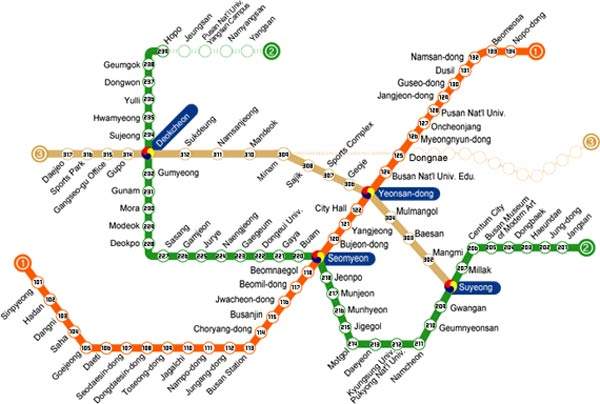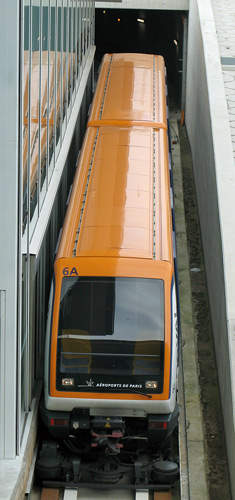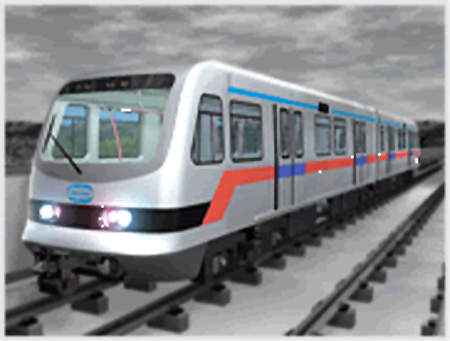Busan (also Pusan) is on the south east coast of South Korea – officially termed the Republic of Korea. Classified as a Metropolitan City, it is the country’s second-largest urban area after the capital, Seoul. In spite of slow-down in the early years of the 21st century after several decades of extreme growth, South Korea remains a great economic force and with a manufacturing base that encompasses a railway industry with international interests.
Busan is terminus for a Korean Railways TGV-based KTX 2hr 50min service from Seoul that, even before completion of high-speed line throughout, has proved an effective challenger to airline competitors.
THE PROJECT
Now run by the Busan Transportation Corporation, the city has a three-line metro system, of which the first line opened in 1985. With the system just less than 100km long (2008), an eastern branch of Line 3 and a northern extension of Line 2 are under construction.
However, neither this network nor national heavy rail connects with the international airport which is located about 22km (13 miles) to the west in the city of Gimhae (also Kimhae).
Approved in 1992 and the subject of speculation about suppliers and format over several years, substantial work on the Busan Gimhae Light Rail project finally began in February 2006. A national report on public-private partnerships for infrastructure developments published in August 2007 put the project cost at 774bn Won ($790m), with a state subsidy of 292bn Won ($298m).
Using automatic light rail is expected to yield significant construction and operational savings over alternatives such as expanding the area’s present metro. Although the system will not have the carrying capacity of the metro, it will greatly exceed the capability of road-based public transport and offer shorter journey times.
Assuming popular acceptance, it is expected that the service will help relieve road congestion in and between the two cities. The specially formed project company is the Busan-Gimhae Light Rail Transit Co., Ltd. The line’s turnkey contract was won by Korean-based Hyundai Rotem, a Hyundai Kia Automotive Group subsidiary, who will be delivering the operational system, with some aspects covered by contracted partners.
INFRASTRUCTURE
There are 18 stations due to be built on the largely elevated line that will run between Busan’s Sasang station and Samgye Dong station in South Gyeongsang Province and will include two major river crossings. Currently offering rail links via a bus service connecting at Deokcheon on metro Line 2 and Gupo on the national network, Gimhae International Airport will be served by the light rail line.
The 23.5km (14.6 miles) route will, unlike the competing Siemens VAL automatic system, use steel wheel on steel rail. Current pickup will be via third rail, the €6m supply contract for aluminium alloy conductor rails, related components, installation and commissioning being announced by München-based Balfour Beatty Rail GmbH Export Division in November 2007. The components are due to have been delivered from Germany by late 2008.
ROLLING STOCK
Hyundai Rotem will be suppliers and maintainers of the rolling stock, the first domestic application of their LRV type. The driverless trains, of which 50 units have been ordered, are due to run at 3min intervals and give a 30min end-to-end timing.
SIGNALLING AND COMMUNICATIONS
Hyundai Rotem has engaged Alcatel-Lucent for the line’s communications infrastructure. The optical and access network solutions will connect and monitor various voice and data services including private automatic branch exchanges, public address systems, automatic fare collection, closed-circuit television and the emergency hotline. It will also connect station management systems and train radio systems. The network’s communications control centre is to be located in Gimhae.
THE FUTURE
The Busan Gimhae Light Rail is projected to open in August 2010, the same year as another system featuring Rotem automatic vehicles is due, the 19km (11.8 mile) Canada Line, formerly the Richmond-Airport-Vancouver line. With Siemens VAL and Bombardier ART systems continuing to gain international orders, Hyundai Rotem will be keen to demonstrate their automatic light rail products to domestic and overseas markets.
A host of the 2002 Asian Games, in 2005 Busan submitted a bid for the summer 2020 Olympics Games. If this bid proves to be successful, it is likely to prove a stimulus for more development of the area’s rail systems.




